Pekka Buttler (Updated 5/2025)
Basic Information on the M42 mount:
The M42 lens mount (also referred to as m42, ‘Praktica mount’, ‘Pentax mount’ and ‘universal screw/thread mount’) is the quintessential thread mount for SLR’s and is as close to a standard lens mount as the SLR industry has ever had.
Obviously, the M42 mount has its lacks and failings – as copiously illustrated by the many ‘improvements’ offered for it through the decades. But as those ‘improvements’ also demonstrate, none of those failings were terminal. The main reason for camera manufacturers launching their own, proprietary mounts was not the failings of the M42 mount, but was instead economical (read more on that here).
Even so, in this article, JAPB will offer a quick guided tour through the high points1 of the development of the M42 lens mount.
M42 mount specifications
Mount type: Thread-mount
Thread specifications: diameter 42 mm, 1 mm thread pitch.
Flange focal distance: 45,46 mm
Film format: 36mm x 24mm (‘Full frame’)
Mount communication: depends on variant. See below for details.
Variants of the M42 mount:
The original: M42 with no body–lens communication
The M42 was first used in 1949 by the Contax S SLR camera by VEB Zeiss Ikon (East Germany). At its simplest, and in their original form, M42 lenses have no communication with the camera body (the thread mount is just a method for securely attaching the lens) and the lenses have no other controls than two rings: one for focusing, and another for setting the aperture. Such lenses in no way communicate with the camera body – neither do they transmit the selected aperture to the body, nor can the body control the aperture.
This lack of any lens-camera communication however produced the downside that – if you wanted to use the lens stopped down, your viewfinder would be extremely dim2 and both framing and focusing would be quite difficult.
Therefore, one would either have to focus and compose the picture wide open and then remember to stop down to gain adequate depth-of-field (or short enough shutter time) or contend with trying to peer through a very dim viewfinder. Later preset and auto -lenses addressed this problem, but there are M42 lenses – typically either very old or very cheap – that function according to this principle. For an example, see picture below.
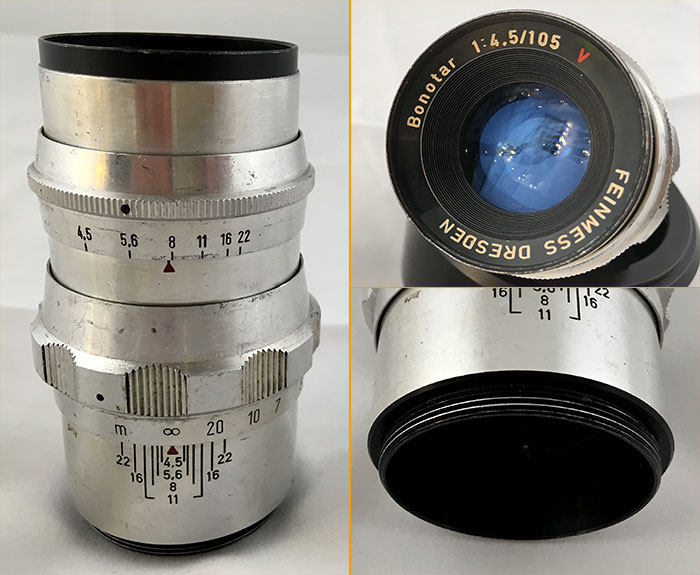
The upper ring operates the aperture directly, and the M42 mount is just a thin tube of aluminum with threads. The aperture ring does not have clicks, and the “stops” are not evenly spaced.
M42 ‘Preset’ lenses
Preset lenses were a further development of directly coupled lenses, designed to address the central usability issue stemming from that focusing (and composing) was best done with a wide-open aperture, whereas shutter timings and requirements regarding depth-of-field often necessitated shooting stopped down.
Preset lenses typically have dual aperture rings: the actual aperture ring that works based on direct coupling (and typically has no clicks), and the preset ring, which would be used to limit the aperture ring’s movement. As there are multiple user interface arrangements of preset lenses, see pictures and captions below.
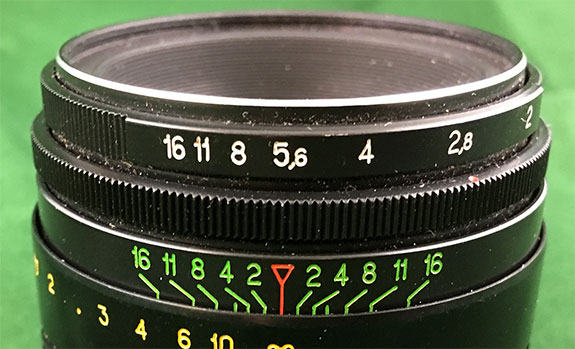
The topmost ring (with numbered stops) is the preset ring, and it has clicks. The actual aperture ring is the ribbed ring below, with a small red dot indicating the actual aperture (f/2.8)
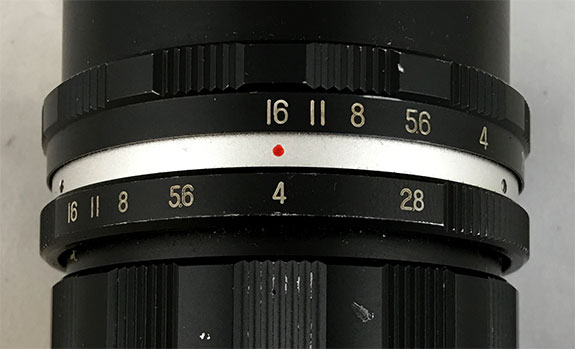
The topmost ring is (again) the preset ring, currently allowing full (f/2.8–f/16) movement of the aperture. The actual aperture ring is the one below, currently set to f/4. Note that both rings are numbered.
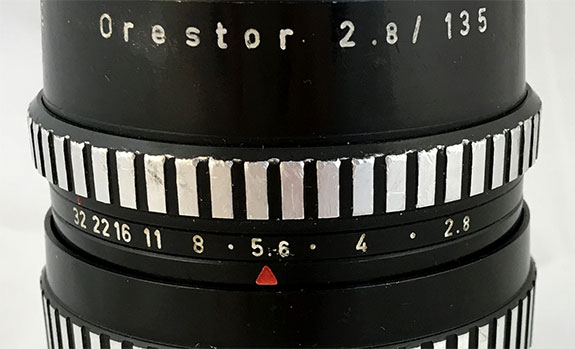
This lens can easily be mistaken for a direct-coupling lens, because the preset ring is not obvious. Note the red triangle below ‘5.6’, which indicates the current aperture, and the red dot above ’32’ which indicates the upper end of the aperture range. The preset-action of this lens is activated by pushing the entire aperture ring forward and turning it to a new setting.
The way in which preset lenses were used on film cameras would be that the photographer would first set the intended aperture (based either on metering or rules-of-thumb) on the preset ring, then turn the aperture to fully open, compose-and-focus, and could then – without taking the camera from their eye – twist the aperture ring to the preset, and take the shot.
From the viewpoint of the photographer using their lens on a modern digital camera, this all might seem archaic, but preset lenses have some advantages even today. Firstly, as all (that I know of) preset lenses are without aperture clicks, they lend themselves both to videography and in-between-stops shooting. Secondly, as the aperture mechanism of preset lenses was always operated by a human hand, and not a spring, the aperture mechanism did not need to move as lightly as that of all automatic lenses invariably have to. Therefore, many preset lenses have (from today’s viewpoint) insane numbers of aperture blades (with all the advantages that entails), and are also not bothered by small amounts of oil on the aperture blades.
N.B! Preset lenses are not limited to the M42 mount, and are instead a general phase of pre-auto lenses. For example, the Tokyo Koki lens pictured above, is actually a T-thread lens. That said, they are a significant piece of the M42 history.
The advanced version: M42 lenses that could be stopped down by the camera
While preset lenses were a clear improvement, the arrangement was far from ideal. Especially after the advent of in-body and through-the-lens (TTL) light metering, preset lenses became an untenable proposition (as you would have had to activate the preset once for metering, then deactivate it to check your framing and focus had not shifted, the activate it again to take the shot). In short, some system to a) allow the camera body to command the aperture to close down when needed, and b) keep the aperture open until that time was needed. This was referred to as ‘automatic aperture’ or simply as ‘auto’.
Trivia: people new to legacy lenses are sometimes confused by the repeated appearance of the name ‘auto’ in lenses from the 1960’s and some even mistake this for signifying autofocus. Instead, ‘auto’ in lens names typically just signifies that the lens has the ability to allow its aperture to be closed down to the user-selected value by the camera body.
Vanilla auto-aperture M42 lenses
The idea with these ‘auto’ lenses was to (when set to auto) allow composition and focusing with a fully open aperture, while automatic stopping down for metering and for taking the picture (a lever in the camera body would depress the pin [2] before taking the shot.
This approach to metering would depend on ‘stop-down -metering’, meaning that to meter, the camera user would depress a button or lever on the camera body, which would depress the pin in the lens, stopping it down, whereafter the photographer would be able to see in their viewfinder (or separate indicator), how suitable the exposure was.
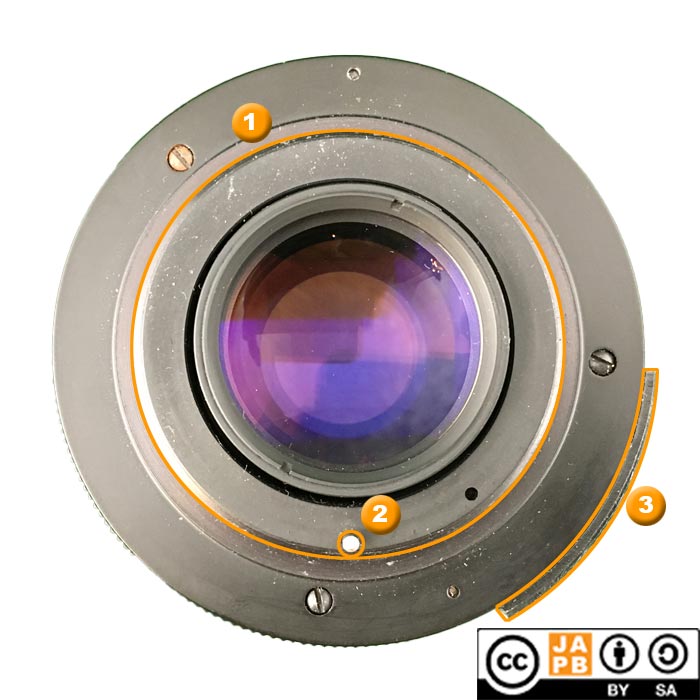
The picture above shows the M42 mount in its most typical form: an ‘auto’ lens.
[1] 42 mm diameter thread (with 1.0 mm thread pitch]
[2] pin for stopping down lens to pre-set aperture (used in automatic mode).
[3] switch for selecting between auto(matic) and manual aperture mode.
However, because there were many camera bodies that did not make use of auto lenses (and because in some situations you actually would not want the auto to engage), M42 auto lenses predominantly featured a switch that would control whether the lens would work in auto mode or in direct coupling mode.
While an absolute majority of M42 auto lenses offer an auto/manual switch, there are also variations. Some ‘auto’ M42 lenses were – for all intents and purposes – auto-only, such as the Meyer Optik Domiplan 50/2.8 pictured below. Others lacked an auto/manual switch, but had an arrangement for stopping down the lens irrespective of the camera body, such as the Meyer-Optik Orestegon 29/2.8 (also pictured below)3. While such lenses are as such just as good as other lenses, they pose a distinct problem for people wanting to adapt them, as the lens either needs to be modified, or the stop-down -pin needs to be jury-rigged4 to be depressed all the time in order to allow any stopping down of the lens.
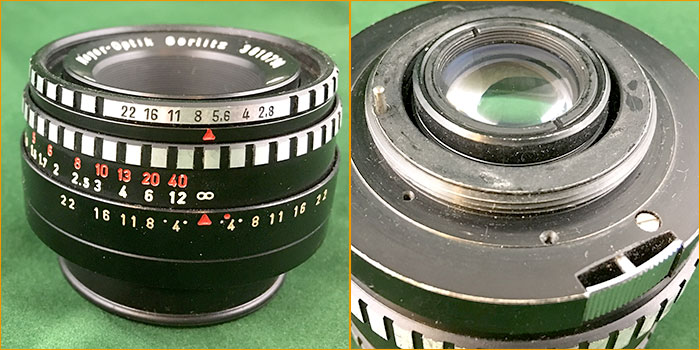
Right: Meyer-Optik Orestegon 29 mm f/2.8 (auto-only with stop-down button on lens).
The Edixa M42
The Wirgin Edixa was a relatively successful series of West German SLR cameras made between ≈1955–1971. Importantly, the Edixa SLR cameras ended up5 implementing the M42 mount with (quite literally) a bit of a twist leading to that Edixa M42 lenses and Praktica/Pentax (and others’) M42 lenses would not align the same way up (see below).
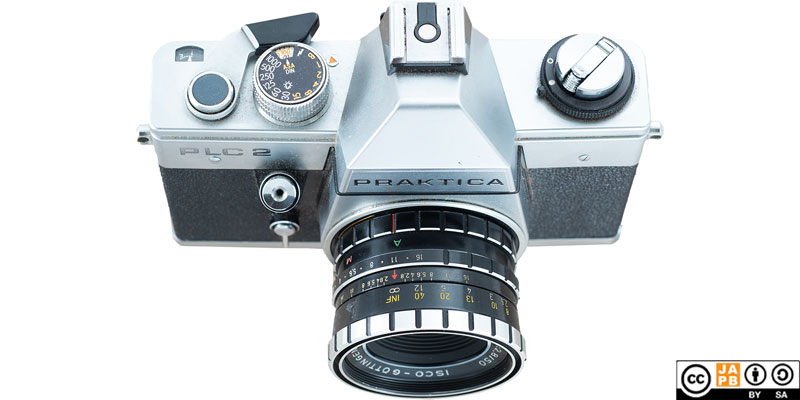
This (relatively) minor difference however means that the aperture stop-down pin of a lens and aperture stop-down lever of a camera do not necessarily line up. Similarly Wirgin/Edixa decided on a subtly different implementation of the aperture stop-down pin, and many who have tried mounting Edixa M42 lenses on adapters with an internal flange to depress the stop-down pin have reported that the lens cannot be mounted all the way in (leading to that the lens does not quite reach infinity).
As a result of this difference, German lens makers subsequently took the habit of clearly indicating whether their lenses were intended for the Edixa or Praktica (vanilla) implementation of the M42 mount.
The endgame: M42 lenses with two-way communication
Two-way communication implies that not only does the body tell the lens when to stop down, but that also the lens has some way of communicating the selected aperture. In this category, there are two types of implementations: mechanical and electronic.
Mechanical implementations
The mechanical approaches to two-way communication still utilised the M42 thread mount [1] and still had the same stop-down pin [2] as earlier implementations. But from there on approaches diverged.
The Pentax way (1969):
Probably the most well-known mechanical implementation of lens-to-body communication was pioneered by Asahi/Pentax. In this implementation an aperture linkage pin [3] was added, which was directly coupled to the aperture ring, thus allowing the body to read the selected aperture. There was a further pin [4] which needed to be depressed to enable activating the auto-setting on the auto/manual selector [5].
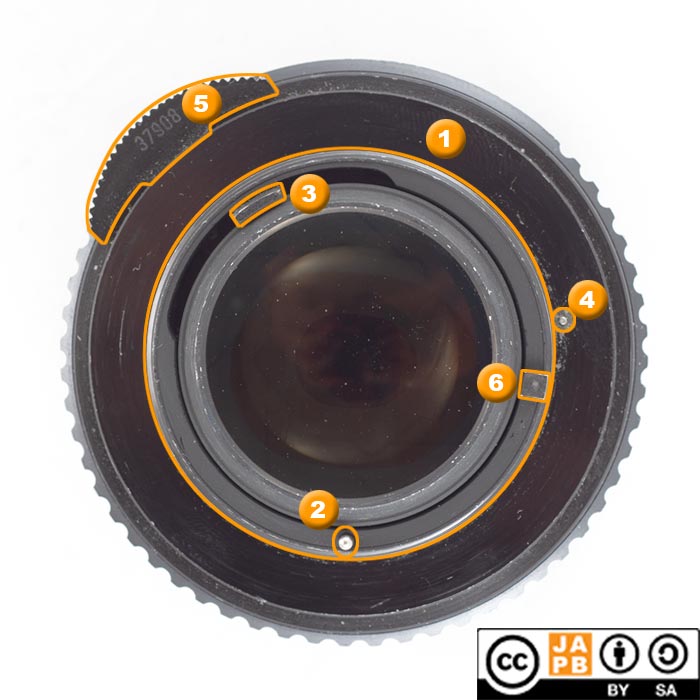
The Picture above shows the mechanical aperture communication method pioneered by Pentax starting in 1969:
[1] 42 mm diameter thread (with 1.0 mm thread pitch]
[2] pin for stopping down lens to user-defined aperture (used in automatic mode).
[3] aperture linkage lever, directly coupled to the aperture ring, thus allowing a compatible body to read the selected aperture.
[4] Feeler pin to activate the auto-setting on the auto/manual selector
[5] Switch for selecting between auto(matic) and manual aperture mode.
[6] Rotation stopper to make sure lens is mounted at correct angle (may hinder using the lens on some cameras not designed with this in mind).
While somewhat convoluted, this approach has the advantage that it does not by default impede cross-system compatibility. You can use these Pentax-M42 lenses on most M42-mount cameras (all the way from the 1949 Contax S to a 2000-something Bessaflex TM) as well as any M42-to-whatever adapter on your digital wonder. No mean feat, considering.
The Zeiss Ikon/Voigtländer way (1972):
Zeiss Ikon (West Germany) had in 1968 finally, reluctantly accepted the M42 mount as basis for its cameras, but was unsurprisingly not happy with the lack of the mount’s ability to communicate the selected aperture. In 1972 Zeiss Ikon introduced the SL706 SLR camera that offered its own system for communicating the selected aperture. Soon afterward Zeiss Ikon threw in the towel and sold its camera manufacturing business (and the Voigtländer subsidiary) to Rollei, which kept on manufacturing the SL706 under the name Voigtländer VSL-1.
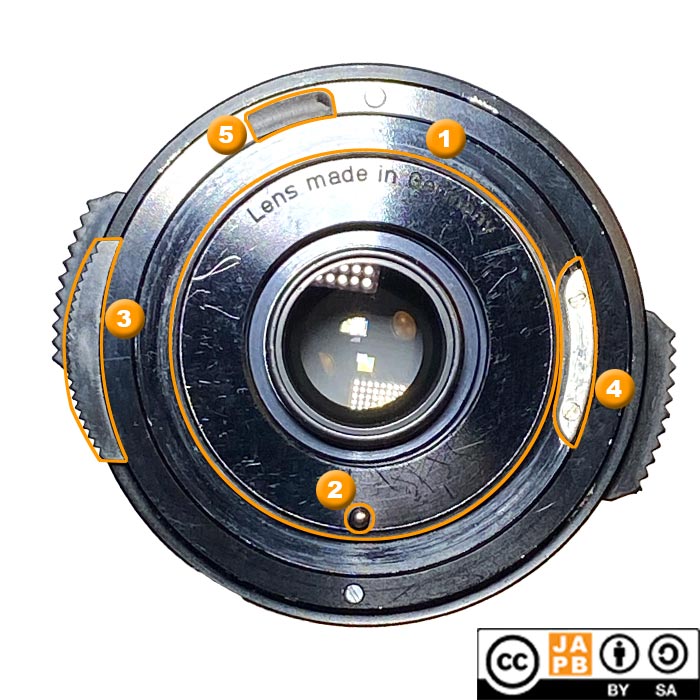
[1] 42 mm diameter thread (with 1.0 mm thread pitch]
[2] pin for stopping down lens to user-defined aperture (used in automatic mode).
[3] depth-of-field preview switch.
[4] Aperture setting indicator (the deeper this can be pressed, the smaller the aperture)
[5] Recess indicating to compatible cameras that this is a lens equipped with [4].
In terms of adapting or cross-compatibility this implementation is wholly benign, as none of the extra interfaces implemented in these Zeiss Ikon/Voigtländer cameras hinder using other lenses or obstruct using these lenses on any other M42 camera or adapter.
The Fujinon way (1972):
Fujinon (Fuji Photo Film) was another Japanese big name in M42 cameras and lenses, and – alike most similar enterprises – in the end abandoned the M42 mount for their proprietary mount (the Fujica-X mount). But before that, also Fuji tried their hand at mechanically extending the M42-mount.
After first having started using a vanilla M42 mount, Fuji in 1972 introduced a new flagship camera (the ST801) geared towards open-aperture metering.
Fuji’s implementation naturally retained the
[1] 42 mm thread mount and
[2] the aperture stop-down pin, but the real extension came in the form of
[6] the aperture ring indicator prong (an extension of the aperture ring towards the camera), and a
[7] locking groove on the M42 flange.
This locking groove existed not only to more securely lock the lens, but also to do so at the precisely correct rotational position, thereby enabling the body to use information ‘read’ from the aperture indicator. Also note the absence of an auto/manual switch.
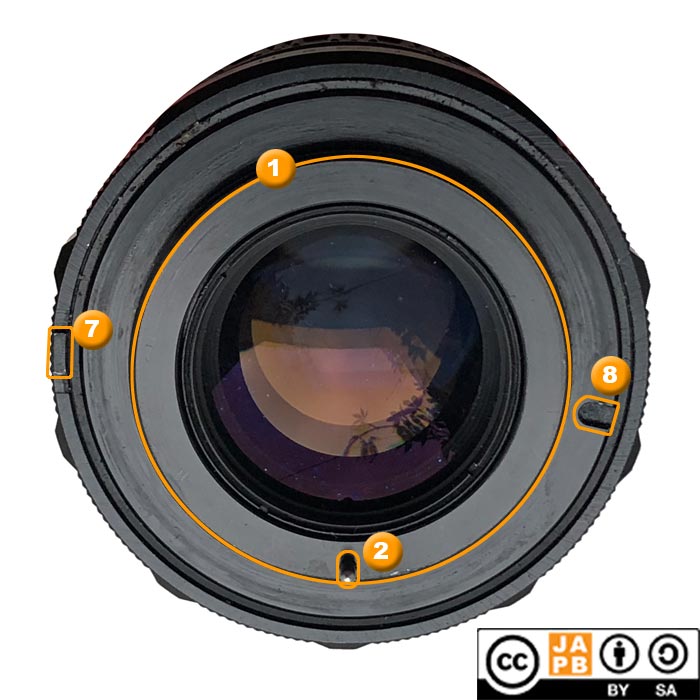
While that aperture indicator prong [6] does not protrude a lot (otherwise it would have engaged one rotation too early), it still protrudes enough to make trouble. Unless the camera body (or adapter) is designed expressly to make room for that prong, such a lens cannot be correctly mounted on said body/adapter. Due to the way the M42 mount works, not being able to rotate the lens all the way in not only leads to a loss of infinity focus, but also leads to a M42 camera not being able to operate the aperture stop-down pin. Adapting these lenses is therefore troublesome, and while I’m aware that the common approach is to file down that aperture indicator prong, I generally do not endorse non-reversible procedures. Instead, there are some M42 adapters that are specifically designed to be able to adapt these lenses. Alternatively, get an M42 adapter with an extra flange (see footnotes), and fix a date for taking it to someone with a lathe to modify the adapter.
The Mamiya way (1974)
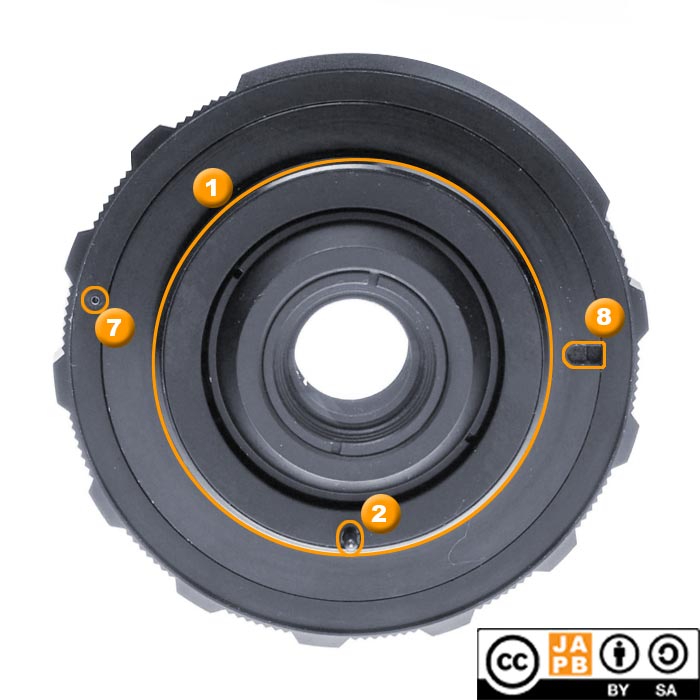
In a move that resembles Fuji’s 1972 move (above), Mamiya in 1974 introduced their own addition to the M42 mount (these lenses have the abbreviation ‘SX’ in their name), which is characterised by:
[1] 42 mm diameter thread (with 1.0 mm thread pitch];
[2] pin for stopping down lens to user-defined aperture;
[7] pin in the aperture ring that allows a compatible camera body is able to read the aperture ring position directly (moves with aperture ring);
[8] locking groove in the base of the flange to secure that the lens is mounted at the correct rotational angle.
Like with the Fujinon adaptation of the M42 mount, the locking apparatus was implemented in a way that did not hinder cross-compatibility. However the aperture ring pin means that Mamiya lenses that have this pin can not be mounted on most M42 cameras (and even make trouble with some adapters). Moreover, because the aperture ring extends a bit further back than on many other M42 lenses, the aperture ring in itself (and not only the pin) may cause incompatibilities. As a result of this, you will find many Mamiya SX lenses where the pin and even the base of the aperture ring have been milled or filed away.
Electronic implementations
The electronic approach naturally retained the M42 thread-mount [1] and stop-down pin [2] and auto/manual switch [5] for backward compatibility, but was otherwise based on three (spring-loaded) electronic contacts on the lens’ mount flange [9], that would communicate with similar contacts on the mount flange on (compatible) camera bodies in order to communicate the lens’ selected aperture. When introduced in 1969, this was the first-ever implementation of electronic communication between lens and camera. The M42 being a thread mount, and with perfect alignment thus being somewhat unreliable, this led to the use of wide tolerances on the camera body’s end of the electronic contacts.
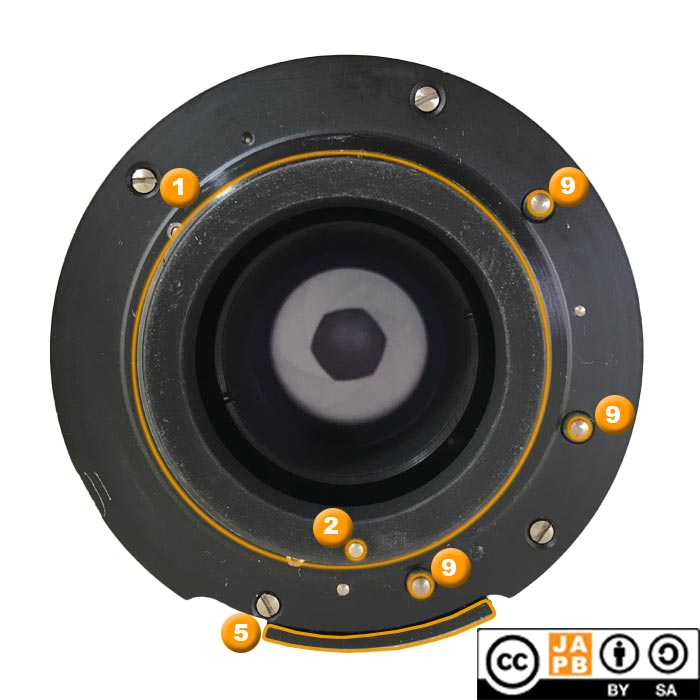
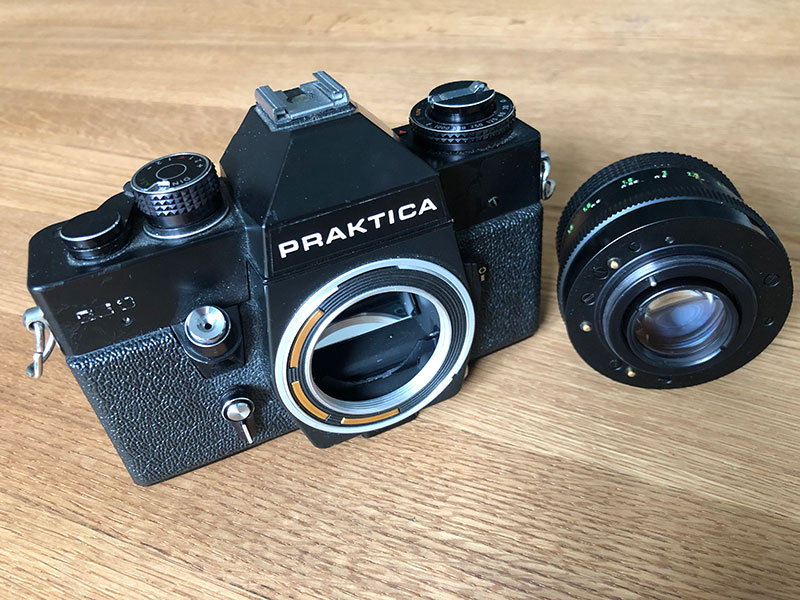
Notice the wide copper strip contacts on the camera mount in response to alignment inexactness.
Adapting M42 lenses
M42 lenses have been adapted to other mounts for about as long as other mounts have existed, partially due to that the M42 mount preceded many other mounts and people tended to already have M42 lenses when they bought their first Minolta/Canon/etc., partially because the M42 mount features many classic lenses. That said, there are huge practical differences in whether you adapt M42 lenses to SLR’s (whether film or digital) or mILC’s.
Adapting M42 lenses on dSLR’s/SLR’s
There are two major issues you need to consider when adapting M42 lenses on SLR’s.
The first is the age-old question of compatible flange focal distances (adapting M42 lenses is easy as long as the camera body’s flange focal distance is comfortably short of the flange focal distance of M42 (45,46 mm), which means that many SLR bodies will be able to fit an M42 lens and adapter ring without losing infinity focus. On the other hand, there are those systems (Nikon F, Leica R, Olympus OM, C/Y, others), that have longer flange focal distances than the M42 mount, and will thus either lead to losing infinity focus, or necessitating an adapter with optics, and the ensuing image degradation and mild teleconversion.
The other major consideration is metering, as (practically) no bodies of other systems will integrate the M42 lens to the camera body’s metering system, in effect forcing you to resort to stop-down metering, meaning that the photographer is suddenly back where M42 started: forced to either peer through dim viewfinder or to focus and compose wide open, then stop down to take the shot 6. Neither of these considerations need affect the user of a mirrorless camera.
Adapting M42 lenses on mILC’s
Firstly, the question of flange focal distances becomes a non-issue, as there is no mirrorless interchangeable lens camera (not even medium format mirrorless), which cannot comfortably fit a M42 lens and dumb adapter.
Secondly, as mirrorless cameras focus and meter on sensor (not using a complicated set of mirrors and prisms), both metering and focusing M42 lenses becomes essentially child’s play, with one small potential hitch: the lens needs to be in manual mode for the aperture to work (or use an adapter that engages the stop-down pin). With (most) adapters not being designed to be able to depress the stop-down pin of M42 lenses, auto-only lenses can only be used wide open (or through jury-rigging the stop-down pin).
Final caveats re adapting:
Firstly, I could tell several tales of shots I’ve botched because I’ve accidentally switched my M42 lens into auto mode (meaning all shots have been made with the aperture wide open). If your shooting habits are as uncontrolled as mine, you might want to consider taping the auto/manual switch solidly to manual.
Secondly, if you’re dealing with Fuji M42 or Mamiya M42 lenses, read the above passages with consideration
Footnotes
- I am aware of some, rather rare variations, which I have yet been unable to find sufficient documentation for, and are thus not covered in this article. ↩︎
- The dim viewfinder was one of the reason for why Twin-lens reflex cameras remained popular: Because the viewing lens would never be stopped down (only the taking lens) the viewfinder would remain bright. ↩︎
- While both pictured examples were Meyer-Optik lenses, this should not be taken to indicate that either a) all Meyer-Optik lenses posed problems or that b) other lens makers are problem free. Au contraire. ↩︎
- To address this issue, there are basically two types of M42 adapters: Those that do not interfere with the auto pin (usable adapted with auto-only lenses only wide open), and those that sport an extra flange that always engage the pin (usable with auto-only lenses, but may obstruct protruding rear lens elements). See picture below.
↩︎ - While I have heard speculations that this difference would have been a deliberate move on Wirgin’s part (trying to lock users into their system), and while this would very much have been par for the course for 1950s-60s West German camera makers (just look what they did with the DKL mount), I cannot say with any certainty. ↩︎
- Granted: this issue can be circumvented using live view on modern dSLR’s. ↩︎
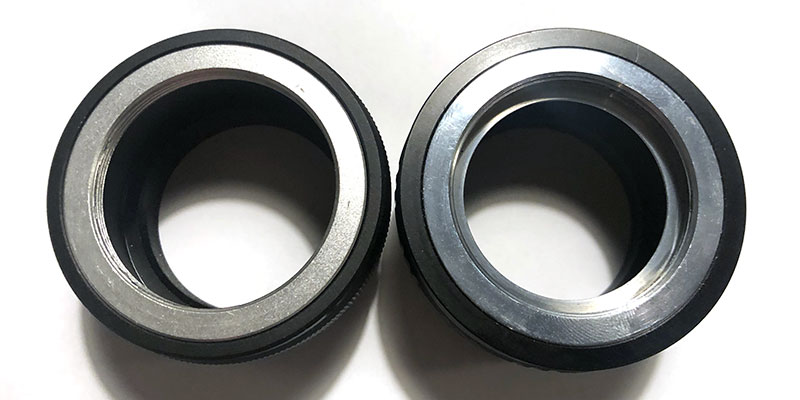
Right: M42-NEX adapter with extra flange